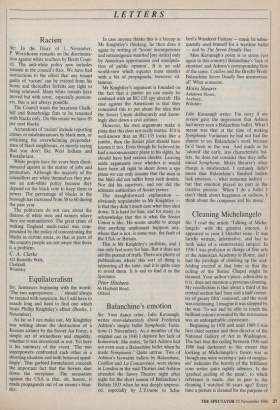Balanchine's emotion Sir: Your dance critic, Julie Kavanagh, writes over-elaborately
about Frederick Ashton's simple ballet Symphonic Varia- tions (1 November). As a member of the original cast in 1946 I deplore her lack of homework. She states, 'In fact Ashton had not even seen a Balanchine ballet when he made Symphonic.' Quite untrue. Two of Ashton's favourite ballets by Balanchine, Corillon and La Concurrence, were shown in London in the mid-Thirties and Ashton attended the Savoy Theatre night after night for the short season of Balanchine's Ballets 1933 when he was deeply impress- ed, especially by L'Errante to Schu- bert's Wanderer Fantasy — music he subse- quently used himself for a wartime ballet — and by The Seven Deadly Sins.
Miss Kavanagh's point is to stress (yet again in this country) Balanchine's 'lack of emotion' and Ashton's corresponding flow of the same. Cotillon and the Brecht-Weill- Balanchine Seven Deadly Sins unemotion- al? What nonsense.
Moira Shearer
Ashdown House, Avebury, Wiltshire
Julie Kavanagh writes: I'm sorry if my review gave the impression that Ashton had never seen a Balanchine ballet. What I meant was that at the time of making Symphonic Variations he had not had the chance to see Balanchine's work because he'd been in the war. And much as he `adored' the early, less characteristic bal- lets, he does not consider that they influ- enced Symphonic. Moira Shearer's other charge is misdirected. I certainly didn't mean that Balanchine's finished ballets lack emotion — what nonsense indeed but that emotion played no part in the creative process: 'When I do a ballet I don't think about happiness or sadness, I think about the composer and his music.'


































































 Previous page
Previous page